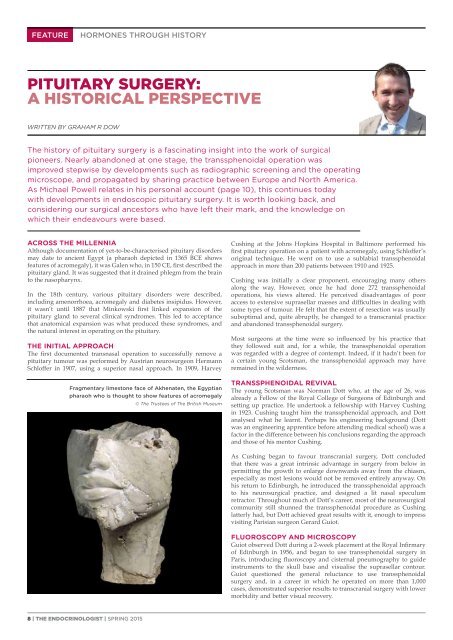1CIShci
1CIShci
1CIShci
Create successful ePaper yourself
Turn your PDF publications into a flip-book with our unique Google optimized e-Paper software.
FEATURE<br />
HORMONES THROUGH HISTORY<br />
PITUITARY SURGERY:<br />
A HISTORICAL PERSPECTIVE<br />
WRITTEN BY GRAHAM R DOW<br />
The history of pituitary surgery is a fascinating insight into the work of surgical<br />
pioneers. Nearly abandoned at one stage, the transsphenoidal operation was<br />
improved stepwise by developments such as radiographic screening and the operating<br />
microscope, and propagated by sharing practice between Europe and North America.<br />
As Michael Powell relates in his personal account (page 10), this continues today<br />
with developments in endoscopic pituitary surgery. It is worth looking back, and<br />
considering our surgical ancestors who have left their mark, and the knowledge on<br />
which their endeavours were based.<br />
ACROSS THE MILLENNIA<br />
Although documentation of yet-to-be-characterised pituitary disorders<br />
may date to ancient Egypt (a pharaoh depicted in 1365 BCE shows<br />
features of acromegaly), it was Galen who, in 150 CE, first described the<br />
pituitary gland. It was suggested that it drained phlegm from the brain<br />
to the nasopharynx.<br />
In the 18th century, various pituitary disorders were described,<br />
including amenorrhoea, acromegaly and diabetes insipidus. However,<br />
it wasn’t until 1887 that Minkowski first linked expansion of the<br />
pituitary gland to several clinical syndromes. This led to acceptance<br />
that anatomical expansion was what produced these syndromes, and<br />
the natural interest in operating on the pituitary.<br />
THE INITIAL APPROACH<br />
The first documented transnasal operation to successfully remove a<br />
pituitary tumour was performed by Austrian neurosurgeon Hermann<br />
Schloffer in 1907, using a superior nasal approach. In 1909, Harvey<br />
Fragmentary limestone face of Akhenaten, the Egyptian<br />
pharaoh who is thought to show features of acromegaly<br />
© The Trustees of The British Museum<br />
Cushing at the Johns Hopkins Hospital in Baltimore performed his<br />
first pituitary operation on a patient with acromegaly, using Schloffer’s<br />
original technique. He went on to use a sublabial transsphenoidal<br />
approach in more than 200 patients between 1910 and 1925.<br />
Cushing was initially a clear proponent, encouraging many others<br />
along the way. However, once he had done 272 transsphenoidal<br />
operations, his views altered. He perceived disadvantages of poor<br />
access to extensive suprasellar masses and difficulties in dealing with<br />
some types of tumour. He felt that the extent of resection was usually<br />
suboptimal and, quite abruptly, he changed to a transcranial practice<br />
and abandoned transsphenoidal surgery.<br />
Most surgeons at the time were so influenced by his practice that<br />
they followed suit and, for a while, the transsphenoidal operation<br />
was regarded with a degree of contempt. Indeed, if it hadn’t been for<br />
a certain young Scotsman, the transsphenoidal approach may have<br />
remained in the wilderness.<br />
TRANSSPHENOIDAL REVIVAL<br />
The young Scotsman was Norman Dott who, at the age of 26, was<br />
already a Fellow of the Royal College of Surgeons of Edinburgh and<br />
setting up practice. He undertook a fellowship with Harvey Cushing<br />
in 1923. Cushing taught him the transsphenoidal approach, and Dott<br />
analysed what he learnt. Perhaps his engineering background (Dott<br />
was an engineering apprentice before attending medical school) was a<br />
factor in the difference between his conclusions regarding the approach<br />
and those of his mentor Cushing.<br />
As Cushing began to favour transcranial surgery, Dott concluded<br />
that there was a great intrinsic advantage in surgery from below in<br />
permitting the growth to enlarge downwards away from the chiasm,<br />
especially as most lesions would not be removed entirely anyway. On<br />
his return to Edinburgh, he introduced the transsphenoidal approach<br />
to his neurosurgical practice, and designed a lit nasal speculum<br />
retractor. Throughout much of Dott’s career, most of the neurosurgical<br />
community still shunned the transsphenoidal procedure as Cushing<br />
latterly had, but Dott achieved great results with it, enough to impress<br />
visiting Parisian surgeon Gerard Guiot.<br />
FLUOROSCOPY AND MICROSCOPY<br />
Guiot observed Dott during a 2-week placement at the Royal Infirmary<br />
of Edinburgh in 1956, and began to use transsphenoidal surgery in<br />
Paris, introducing fluoroscopy and cisternal pneumography to guide<br />
instruments to the skull base and visualise the suprasellar contour.<br />
Guiot questioned the general reluctance to use transsphenoidal<br />
surgery and, in a career in which he operated on more than 1,000<br />
cases, demonstrated superior results to transcranial surgery with lower<br />
morbidity and better visual recovery.<br />
8 | THE ENDOCRINOLOGIST | SPRING 2015


